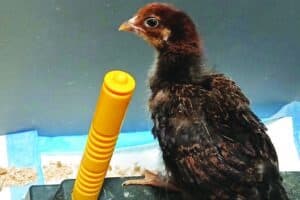Those Russians are sneaky.Russian pavlovskayas, I mean. They’re a type of chicken ó Russia’s most ancient chicken breed ó and we have two of them.One is pure white; the other is multicolored, and that’s the one that tricked us and is now a proud mama. She was one of two broody chickens we had at the same time, but she was more discreet about it. Our other broody chicken, which we call Lurch, remained in the nesting box in plain sight, and every day we would remove eggs from underneath her as she protested. (Lurch is a shamo, a Japanese breed; yes, we have an international flock.) But the other chicken, the Russian, was hiding in a corner of the coop; I didn’t notice her there, nor the dozen eggs or so she had gathered under her.If you’re not familiar with broody chickens, here is an explanation from The Chicken Chick’s website: “A hen that is committed to hatching chicks is known as broody. The state of being broody is controlled by instinct, hormones and lighting conditions. Left to her own devices, a broody hen will lay a clutch of eggs, then stop egg-laying and sit on them for 21 days until they hatch.”In general, the site states, ìA broody chicken prefers a dark, private, comfortable location in which to set.” The corner of the coop was private enough that we had no idea; when we finally spotted her, we didnít know how long the Russian had been nurturing the eggs. Not wanting to pull eggs away that could soon hatch, we left them alone.Obviously, if you don’t have a rooster in your flock, the broody chicken is not going to have any success hatching eggs; it takes two to tango, as they say. In that case, or if there is a rooster and you simply don’t want any chicks to deal with, there are various techniques to breaking the broody cycle in addition to simply removing the eggs.A broody chicken is not picky about what eggs she lays on; in addition to her own, she may “steal” eggs from fellow hens. That was the case in the Russian’s situation; we could tell since different chickens lay different-colored eggs.According to scoopfromthecoop.com, a hen from pretty much any breed can turn broody, although most egg production hybrids and white-egg breeds rarely do. It’s pretty easy to tell if a chicken is broody. They get very protective; the Russian would cluck and peck at us when we would try to reach or peek under her. They hardly ever leave the nest. They may pull out their breast feathers and use them to line the nest. Some chickens even growl.Over the hen’s protests, Margaret would check the eggs regularly as the days went by. When she began to hear peeping from some of the eggs, we knew the time was near.Out of the dozen or so eggs, five hatched before the mom abandoned the remaining eggs to look after her newborn chicks. At that point, we moved the hen and chicks to a more private and secure location in the garage. One chick died a few days later; the remaining four ó three dark-colored fluff balls and one yellow one ó are all doing well. We asked the breeder from the place we got the Russian pavlovskayas if we should intervene in the care of the babies, and were assured that as long as we provided food and water, the mom would do all the work ó and she has. The mama is as protective of her babies as she was of her eggs.Now the big question is one of gender. Do we have four hens, four roosters or a mix? A rooster would not be our first choice, but if one was a rooster, we’d see if it and our existing rooster could get along or we would seek to re-home it; either way, we would aim for a long and happy life. (In the egg industry, being born male is typically a death sentence.)The other question: When do they all go outside to join their flock mates? I took the chicks and the mom out to a segment of the chicken pen for fun in the sun and the babies showed they could easily squeeze through the fencing, so it will require at least a couple more weeks of growing before I can trust that they’ll be safe outside. The advice I read online varies greatly about when to introduce chicks to the flock ó anywhere from six weeks to 16. We’ll do introductions slowly, having the chicks and mom segregated for some time in their own section of the chicken pen. After that, hopefully they’ll become one big, happy, feathered family.






